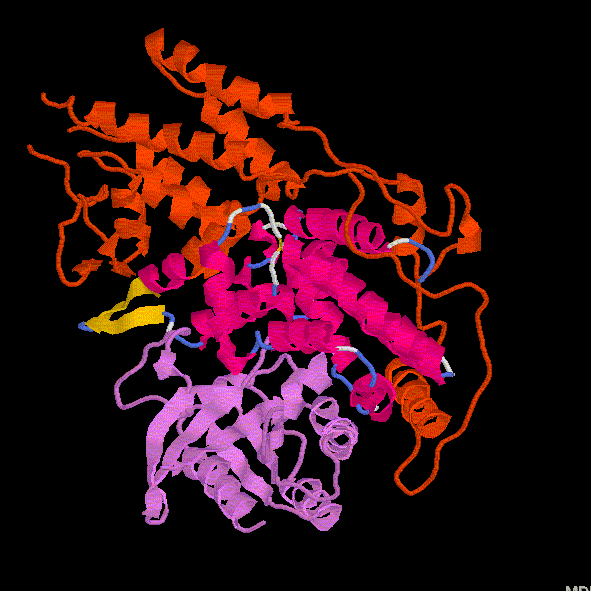
CDD: smart00147
PFAM: PF00617
InterPro: IPR000651
SMART: SM0147

Complex Of Human H-Ras With Human Sos-1 (red chain)
Authors: P. A. Boriack-Sjodin, S. M. Margarit,
D. B. Sagi, J. Kuriyan
pdb file: 1BKD
jpeg generated from pdb file 1BKD
using Chime
Description
The RasGEF domain is an N-terminal motif with many alpha-helices. The domain belongs to the CDC25 family that ranges from 309 to 1596 amino acid residues. There is a sequence similarity shared by the proteins of this family of about 250 amino acids in their C-terminal section.
This domain plays an important role in dissociation of
GDP, as well as allowing GTP binding and activation of the GTPases.
During neuronal development, the son of sevenless (sos) protein specifically
facillitates the exchange of Ras-bound GDP by GTP. Ras proteins act
as switches that bind GTP and GDP, then slowly hydrolyze GTP to GDP (MedLine:
91095015).
Examples of proteins containing the RasGEF Domain
Human Sos1
A guanine nucleotide exchange factor for Ras that binds
to GRB2
MedLine: 8493579
LocusLink: 6654
RA-GEF-2
A Rap guanine nucleotide exchange factor that serves
as a downstream target of M-Ras
PubMed: 11524421
LocusLink: 51735
RasGRP4
A Ras activator isolated from acute myeloid leukemia
PubMed: 11880369
LocusLink 115727
RalGDS-like
Cloning, expression analysis and genomic organization
MedLine: 20225471
LocusLink:
23179
Cdc25GEF (GNRP)
A brain guanine nucleotide-exchange
factor that regulates the function of Ras
MedLine:
95129875
LocusLink: 5923
EPAC
a Rap1 guanine-nucleotide-exchange factor directly activated
by cyclic AMP
MedLine:
99068645
LocusLink: 10411
Human Disease
Gingival Fibromatosis type 1(OMIM: 135300)
Gingival fibromatosis is a inherited condition characterized
by an increased growth of a benign, slowly advancing, nonhemorrhagic, fibrous
expansion of maxillary and mandibular keratinized gingiva. There
are two known forms of gingival fibromatosis: genetic and pharmacologically
induced. Hereditary gingival fibromatosis is the most common genetic
form (PubMed: 9529355),
and is usually transmitted as an autosomal dominant trait, although cases
of autosomal recessive inheritance has been reported. The disorder
was caused by insertion of a cytosine between nucleotides in the SOS1 gene
(OMIM: 182530).
The insertion mutation introduced a frameshift which created a premature
stop codon. (PubMed: 11868160)
This mutation eliminates 4 important SH3 binding domains which are normally
present in the c-terminal region of the SOS1 protein.
Submitted by:
Jessica Grant and Sarah Johnson
Cell Biology Class
Shippensburg University
12/03/02
Edited by:
William J. Patrie 12/16/02